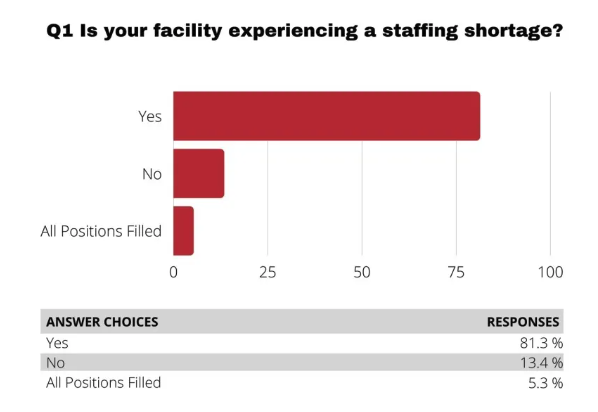
How Healthcare Organizations Are Addressing the Radiology Tech Shortage
Unblocking access to timely radiology services
The radiology tech shortage is one of the most challenging problems in the radiology industry today, as it disrupts care delivery of diagnostic imaging exams and interventional radiology procedures. The unmet need for licensed radiology technicians has the potential to negatively impact patients, hospitals, imaging centers, and independent delivery networks (IDNs). Some of the challenges that imaging departments face because of the shortage include:
- Lower quality of care
The labor shortage creates a decreased capacity for procedures in an imaging department. This lowers the quality of care by limiting appointment availability, delaying diagnosis and treatment and impacting patient outcomes. - Negative patient experiences
Delayed appointments frustrate patients who already may be stressed about their health, lowering patient satisfaction scores and possibly damaging the reputation of the healthcare organization and/or imaging department. - Increased workload
The radiology tech shortage forces added tasks and longer hours onto existing staff, creating an environment that can lower team morale and cause employee burnout. - Increased operational costs
The radiology tech shortage can drive up salaries and competition for job candidates. This often results in healthcare organizations adding expensive financial incentives to attract qualified technologists. By reducing the labor shortage, healthcare organizations may be able to lower their costs and improve their bottom line.
For all these reasons and more, healthcare organizations are actively looking for effective ways to address this labor shortage. According to an article in Applied Radiology, “Radiology, experiencing shortages across various positions and modalities, is struggling to maintain staffing levels and bring in new talent.”
Causes of the radiology tech shortage
There are more than 330,000 ARRT-registered radiologic technologists in the U.S., according to the American Registry of Radiologic Technologists (ARRT). The U.S. Bureau of Labor Statistics (BLS) reports that employment of radiologic technologists is anticipated to grow 6% from 2021 to 2031. BLS predicts that about 16,600 new job openings will become available each year over the next decade and states, “The growing size of the older population will lead to greater demand for healthcare services, including diagnostic procedures. More radiologic and MRI technologists will be needed to perform the imaging exams that are essential for making diagnosis and creating treatment plans.”
According to Eric M Rubin, MD, FACR, chair of the American College of Radiology (ACR), “We’re seeing workforce shortages that are widespread, and they’re coming for multiple reasons. We’re experiencing an increasing overall workload as the impact of the Baby Boomer generation is in full force. We’re seeing an increase in the need for subspeciality reads in radiology, and also an increasingly fluid workforce where people are more likely to switch jobs.”4
In recent years, the demand for radiology technologists has increased for several reasons:
- An aging population has created more demand for medical imaging utilization. Falls and associated injuries, more common among senior citizens, often require medical imaging such as X-ray or ultrasound to assess the injury. Also required for seniors is imaging to help detect, diagnose, and assess disease, such as cancers.
- Advances in imaging technology and equipment (such as CT and MRI scanners) require skilled operation and maintenance, which increases the demand for highly trained radiology techs.
- A strong focus on early detection and preventive healthcare is well-accepted and more important than ever to reduce the rising burden of chronic disease and the increasing cost of healthcare.
According to the Advanced Health Education Center (AHEC), a recent survey of 350 rad tech participants from 34 states shows that for about 81% of respondents, their medical facility is experiencing a staffing shortage. Radiography, CT, and MRI are the modalities most affected. Nearly 23% say that their organization’s imaging services have been reduced due to the staffing shortages, and over 50% say that overtime is the number one method their facility uses to deal with the shortage.

Advanced Health Education Center (AHEC) Survey
Despite the need for these trained professionals, many young people do not consider radiologic technology as a career. This is due in part to lack of awareness of the opportunities. In addition, there are insufficient programs to train the number of techs needed. The Joint Review Committee on Education in Radiologic Technology accredits programs for radiography and MRI.
Addressing this shortage is a major challenge and will require a multi-pronged approach.
Shortages in U.S. geographies and radiology specialties
Due to a limited pool of job candidates, lower salaries, and fewer professional growth opportunities, radiology tech shortages can be severe in many rural areas. Also facing shortages are high-demand areas, such as urban centers and locations with a larger percentage of the population consisting of senior citizens.
In addition, certain radiology specialty areas are suffering tougher shortages, such as advanced imaging techniques. Technicians who work in areas such as nuclear medicine, radiation therapy, and interventional radiology require significant training and experience, which contributes to the radiology tech shortage in these areas. (See table 1, below.) In addition, there are relatively few training programs for MRI and CT technology.
Table 1: Specialties suffering radiology tech shortages
| Radiation Therapy | Therapists administer radiation treatments to patients with cancer. |
| Nuclear Medicine | Technologists work with radioactive materials to create images of organs and tissues. |
| Interventional Radiology | An area growing in utilization demand, this technique uses imaging to guide procedures such as biopsies or vascular access. |
To address labor shortages in these specialty areas, many healthcare organizations offer incentives to attract qualified candidates, among other strategies.
How healthcare organizations recruit and retain radiology techs
Healthcare organizations depend on radiologic technologists to adjust and maintain imaging equipment, follow physician orders, prepare patients for procedures, keep patient records, use advanced equipment to create medical images, and much more.
Imaging departments may begin to address their staffing needs by hiring temporary allied healthcare professionals to assist where possible. Because many responsibilities require certified radiology techs, healthcare organizations must take additional steps to reduce the impact of the shortage:
- Offering radiology technologists financial and training incentives such as sign-on bonuses, relocation assistance, tuition reimbursement and loan forgiveness programs.
- Investing in healthcare business intelligence and other technology to automate image processing and analysis, reducing workload for staff members and increasing efficiency.
- Expanding telemedicine to include remote imaging services that leverage the expertise of radiology technologists in different locations.
Telemedicine can ease the labor shortage
Radiology providers can use telemedicine to deliver remote imaging services to patients in a variety of ways, including:
- Teleradiology
Clinicians can transmit medical images to another location for interpretation and diagnosis and provide quick radiological expertise. - Teleconsultation
By facilitating consultations between a radiologist and the referring physician, clinicians can quickly discuss findings and recommendations, improving communication and patient outcomes. - Remote monitoring
Radiology staff can remotely monitor patients who have had imaging procedures to evaluate their recovery or track progress. This can help ensure that patients receive appropriate follow-up care.
The use of telemedicine in radiology can reduce the impact of the labor shortage, improve access to imaging services, increase efficiency at clinics, hospitals, and IDNs, and improve patient outcomes.
Steps to avoid future radiology tech shortages
Looking toward the future, healthcare organizations can spearhead initiatives to minimize radiology technician shortages in years to come, such as:
- Work with educational institutions to develop and expand training programs and increase the number of radiologic technologists entering the workforce.
- Collaborate with professional organizations to promote the profession and its unique opportunities help people, to use sophisticated medical and computer equipment, and to have job stability and good earning potential.
- Increase investment in technology that can help automate data analysis to uncover information that can streamline process and increase efficiency.
- Advocate for policy changes at the federal and state levels such as increased funding for education and changes to immigration policies. (See Table 2, below).
Download the Utilization Analytics Datasheet
Table 2: How healthcare organizations advocate for policy change
| Healthcare companies may lobby government officials at the federal and state levels to increase funding for education and training programs for radiology technicians. They may also push for changes to immigration policies to make it easier for qualified radiology techs to work in the United States. |
| Support professional organizations that represent radiology technicians, such as the American Society of Radiologic Technologists (ASRT). These organizations may lobby for policy changes on behalf of their members. |
| Work with educational institutions to develop and implement programs that train more individuals to become radiology technologists. They may also provide funding or resources to support these programs. |
| Collaborate with other stakeholders, such as imaging departments, clinics, IDNs, and insurers, to work toward policy changes that address the labor shortage, such as promoting the utilization of telemedicine and healthcare business intelligence to increase radiology services to underserved populations. |
Through a multi-pronged approach of education, technology, and advocacy, healthcare organizations can help reduce or prevent radiology tech shortages in future years.
Outlook on the labor shortage in radiology
The shortage of radiologic technologists creates serious challenges for healthcare providers and patients alike. However, healthcare organizations are taking important steps to mitigate the problem. Through promoting awareness, recruitment efforts, and expanding educational programs, more people are pursuing the training required for this role. In addition, telemedicine, automated analysis, and other new technologies help to bridge the gap in labor by improving efficiency and productivity.
By overcoming the challenges of radiology tech shortages and making radiological services readily available, U.S. healthcare providers can deliver quality healthcare, improve patient outcomes, and reduce healthcare costs.
Explore the Possibilities
With more than 1 million exams examined each day by Glassbeam solutions, see how top organizations are transforming their log data into impactful insights.
Transform Your Healthcare Operations
See how to gain deeper, clearer insight from your machine data to elevate business intelligence and to improve your operational uptime, utilization, and efficiency.

